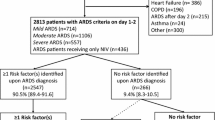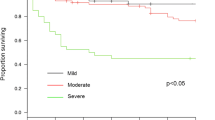Abstract
Purpose
We previously reported a study of systemic inflammatory response syndrome (SIRS) cases in the Tohoku district of Japan in which the patients showed a 30-day mortality from acute lung injury/acute respiratory distress syndrome (ALI/ARDS) of about 20%. Cases in which chest X-ray findings did not meet ALI/ARDS criteria were diagnosed as acute hypoxemic respiratory failure (AHRF), but about 50% of these patients progressed to ALI/ARDS. The objective of this study was to verify the findings obtained in the earlier study and to gain further insights into the pathognomonic symptoms of AHRF associated with SIRS.
Methods
A prospective cohort study was performed in SIRS patients admitted to the intensive care unit (ICU) with PaO2/fractional inspired oxygen (FIO2) ≤ 300 mmHg. Patients were assigned to ALI or ARDS groups based on symptoms at ICU entry. Cases in which chest X-ray showed no infiltration shadows in bilateral lung fields were classified as AHRF.
Results
A total of 240 patients were enrolled in the study. The 30-day mortalities were 21.6% and 20.0% in the ALI and ARDS groups, respectively. Of the 88 AHRF patients, 49 progressed to ALI/ARDS, with progression occurring within 3 days after ICU entry in most cases; 39 patients recovered with no progression. Chest X-ray and computed tomography (CT) showed no findings indicating ALI/ARDS in 20 AHRF patients at ICU entry, but 7 of these patients progressed to ALI/ARDS.
Conclusion
The mortality rates of ALI and ARDS were 21.6% and 20.5%, respectively. More than half of the AHRF patients progressed to ALI or ARDS. Some AHRF patients had normal findings on chest CT, but subsequently showed a bilateral shadow on a chest X-ray. This indicates that mild pathologic lesions may not show imaging abnormalities.





Similar content being viewed by others
References
Ware LB, Matthay MA. The acute respiratory distress syndrome. N Engl J Med. 2000;342:1334–49.
Matthay MA. Clinical measurement of pulmonary edema. Chest. 2002;122:1877–9.
Doyle RL, Szaflarski N, Modin GW, Wiener-Kronish JP, Matthay M. Identification of patients with acute lung injury. Predictors of mortality. Am J Respir Crit Care Med. 1995;152:1818–24.
Ferring M, Vincent J-L. Is outcome from ARDS related to the severity of respiratory failure? Eur Respir J. 1997;10:1297–300.
Mancebo J, Fernández R, Lluis B, Rialp G, Gordo F, Ferrer M, Rodríguez F, Garro P, Ricart P, Vallverdú I, Gich I, Castaño J, Saura P, Domínguez G, Bonet A, Albert RK. A multicenter trial of prolonged prone ventilation in severe acute respiratory distress syndrome. Am J Respir Crit Care Med. 2006;173:1233–9.
Rocco TR Jr, Reinert SE, Cioffi W, Harrington D, Buczko G, Simms HH. A 9-year, single institution, retrospective review of death rate and prognostic factors in adult respiratory distress syndrome. Ann Surg. 2001;233:414–22.
Ashbaugh DG, Bigelow DB, Petty TL, Levine BE. Acute respiratory distress in adults. Lancet. 1967;2:319–23.
Kraft P, Fridrich P, Pernerstorfer T, Fitzgerald RD, Koc D, Schneider B, Hammerle AF, Steltzer H. The acute respiratory distress syndrome: definitions, severity and clinical outcome. An analysis of 101 clinical investigations. Intensive Care Med. 1996;22:519–29.
Rubenfeld GD, Caldwell E, Peabody E, Weaver J, Martin DP, Neff M, Stern EJ, Hudson LD. Incidence and outcome of acute lung injury. N Engl J Med. 2005;353:1685–93.
Zambon M, Vincent JL. Mortality rates for patients with acute lung injury/ARDS have decreased over time. Chest. 2008;133:1120–7.
Bernard GR, Artigas A, Brigham KL, Carlet J, Falke K, Hudson L, Lamy M, Legall JR, Morris A, Spragg R, and the Consensus Committee. The American-European Consensus Conference on ARDS. Definitions, mechanism, relevant outcomes, and clinical trial coordination. Am J Respir Crit Care Med. 1994;149:818–24.
Bernard GR. Acute respiratory distress syndrome. A historical perspective. Am J Respir Crit Care Med. 2005;172:798–806.
The Irish Critical Care Trial Group. Acute lung injury and the acute respiratory distress syndrome in Ireland. A prospective audit of epidemiology and management. CritCare. 2008;12:R30.
Tajimi K, Takezawa J, Ujike Y, Matsukawa S, Usuda Y, Taenaka N, Amaha K. Report of the Commitee on Acute Respiratory Failure, Japanese Society of Respiratory Care Medicine (in Japanese). Jpn J Resp Care. 1999;16:33–42.
Endo S, Miyate Y, Hirota K, Tajimi K, Kato M, Kawamae K, Murakawa M. The Tohoku ALI study group: a survey on acute respiratory failure in intensive care unit patients (in Japanese). J Jpn Soc Emerg Med. 2007;10:415–21.
Murray JF, Matthay MA, Luce JM, Flick MR. An expanded definition of the adult respiratory distress syndrome. Am Rev Respir Dis. 1988;138:720–3.
Tamakuma S, Ogawa M, Aikawa N, Kubota T, Hirasawa H, Isizaka A, Taenaka N, Hamada C, Matsuoka S, Abiru T. Relationship between neutrophil elastase and acute lung injury in humans. Pulm Pharmacol Ther. 2004;17:271–9.
Amato MBP, Barbas CSV, Medeiros DM, Magaldi RB, Schettino GDPP, Lorenzi-Filho G, Kairalla RA, Dehienzelin D, Munoz C, Oliveira R, Takagaki TY, Carvalho RR. Effect of a protective-ventilation strategy on mortality in the acute respiratory distress syndrome. N Engl J Med. 1998;338:347–54.
The Acute Respiratory Distress Syndrome Network. Ventilation with lower tidal volumes as compared with traditional tidal volumes for acute lung injury and the acute respiratory distress syndrome. N Engl J Med. 2000;342:1301–08.
Mercat A, Richard JM, Vielle B, Jaber S, Osman D, Diehl J, Lefant J, Part G, Richecoeur J, Nieszkowska A, Gervais C, Baudot J, Bouadma L, Brochard L, for the Expiratory Pressure (Express) Study Group. Positive end-expiratory pressure setting in adults with acute lung injury and acute respiratory distress syndrome. A randomized controlled trial. JAMA. 2008;299:646–55.
Meade MO, Cook DJ, Guyatt GH, Slutsky AS, Arabi YM, Cooper DJ, Davies AR, Hand LE, Zhou Q, Thabane L, Austin P, Lapinsky S, Baxter A, Russell J, Skrobik Y, Ronco JJ, Stewart TE. Ventilation strategy using low tidal volumes, recruitment maneuvers, and high positive end-expiratory pressure for acute lung injury and acute respiratory distress syndrome. A randomized controlled trial. JAMA. 2008;299:637–45.
The National Heart, Lung, and Blood Institute Acute Respiratory Distress Syndrome (ARDS) Clinical Trials Network. Comparison of two fluid-management strategies in acute lung injury. N Engl J Med. 2006;354:2564–75.
Phua J, Badia JR, Adhikari NK, Friedrich JO, Fowler RA, Singh JM, Scales DC, Stather DR, Li A, Jones A, Gattas DJ, Hallett D, Tomlinson G, Stewart TE, Ferguson ND. Has mortality from acute respiratory distress syndrome decreased over time? A systematic review. Am J Respir Crit Care Med. 2009;179:220–7.
Kallet RH, Jasmer RM, Pittet JF, Tang JF, Campbell AR, Dicker R, Hemphill C, Luce JM. Clinical implementation of the ARDS network protocol is associated with reduced hospital mortality compared with historical controls. Crit Care Med. 2005;33:925–9.
Oda S, Hirasawa H, Kitamura N, Ueno Y, Shimazaki J, Nakanishi K, Fuke N, Ito C. Epidemiology of acute lung injury (ALI)/acute respiratory distress syndrome (ARDS) in Chiba Prefecture: prospective multicenter cohort study of population-based mortality and outcome (in Japanese with English abstract). JJAAM. 2007;18:219–28.
Sumi Y, Ogura H, Akashi K, Tohma Y, Tabuse H, Mizushima Y, Yokota J, Sugimoto H, Fujii C. Improved oxygenation by steroid pulse therapy in early-phase acute respiratory distress syndrome. JJAAM. 2007;18:1–9.
Hoshi K, Kurosawa S, Kato M, Andoh K, Satoh D, Kaise A. Sivelestat, a neutrophil elastase inhibitor, reduces mortality rate of critically ill patients. Tohoku J Exp Med. 2005;207:143–8.
Suchyta MR, Orme JF Jr, Morris AH. The changing face of organ failure in ARDS. Chest. 2003;124:1871–9.
Stapleton RD, Wang BM, Hudson LD, Rubenfeld GD, Caldwell ES, Steinberg KP. Causes and timing of death in patients with ARDS. Chest. 2005;128:525–32.
Martin GS, Eaton S, Mealer M, Moss M. Extravascular lung water in patients with severe sepsis: a prospective cohort study. Crit Care. 2005;9:R74–82.
Takeda S, Ishizaka A, Fujino Y, Fukuoka T, Nagano O, Yamada Y, Takezawa J, Multi-Center Clinical Trial Committee, Japanese Society of Respiratory Care Medicine. Time to change diagnostic criteria of ARDS: toward the disease entity-based subgrouping. Pulm Pharmacol Ther. 2005;18:115–9.
Acknowledgments
We express our appreciation to the following physicians who contributed to the survey conducted by the Tohoku ALI Study Group: Masaki Hata, Department of Cardiovascular Surgery, Aomori Prefectural Central Hospital; Yutaka Mizuno, Department of Surgery, Hachinohe City Hospital; Masayuki Matsui, Department of Anesthesiology, Hirosaki City Hospital; Yoshihiko Kimura, Department of Thoracic Surgery, Akita Kumiai General Hospital; Tokuaki Murakawa, Department of Anesthesiology, Odate Municipal Hospital; Masaya Yabe, Department of Anesthesiology, Ogachi Central Hospital; Kousei Otaka, Department of Anesthesiology, Senboku Kumiai General Hospital; Hiroshi Komatsu, Department of Anesthesiology, Nakadori General Hospital; Masafumi Mitsui, Department of Respiratory Surgery, Noshiroyamamoto Medical Association Hospital; Hirotaka Kato, Department of Surgery, and Takaaki Katayama, Department of Anesthesiology, Iwate Prefectural Iwai Hospital; Nozomi Koyamada, Department of Surgery, Iwate Prefectural Ofunato Hospital; Takashi Mouri, Department of Respiratory Medicine, Iwate Prefectural Kitakami Hospital; Tadashi Abe, Department of Surgery, Iwate Prefectural Kuji Hospital; Yoshiharu Miyate, Intensive Care Unit, and Yoshiaki Mori, Department of Respiratory Medicine, Iwate Prefectural Central Hospital; Toshimichi Sugawara, Department of Surgery, Iwate Prefectural Miyako Hospital; Naoki Tanaka, Department of Surgery, Oshu City Mizusawa Hospital; Kazumi Okamoto, Department of Surgery, Matsuzono 2nd Hospital; Takayuki Suto, Department of Surgery, Morioka Municipal Hospital; Kazuki Konishi, Department of Respiratory Medicine, Morioka Tsunagi Onsen Hospital; Yuji Fujii, Morioka Yuai Hospital; Hideyuki Kamii, Department of Neuroanesthesia, Kohnan Hospital; Chikao Goko, Department of Emergency Medicine, Saka General Hospital; Kohkichi Andoh, Department of Anesthesiology, Sendai City Hospital; Masato Kato, Department of Anesthesiology and Perioperative Medicine, Tohoku University School of Medicine; Kunihiko Hoshi, Intensive Care Unit, Tohoku University Hospital; Masato Kishi, Department of Anesthesiology, Tsuruoka Municipal Shonai Hospital; Hikaru Hoshi, Department of Anesthesiology, Yamagata Prefectural Central Hospital; Shinya Oda, Intensive Care Unit, Yamagata University Hospital; Yukio Matsumoto, Intensive Care Unit, Yonezawa City Hospital; Ryoichi Tosa, Department of Emergency, Critical Care and Traumatology, Aidu Chuo Hospital; Keiichi Kan, Department of Anesthesiology and Critical Care Medicine, Southern Tohoku General Hospital; and Hiromi Muto, Hoshi General Hospital.
Author information
Authors and Affiliations
Consortia
Corresponding author
About this article
Cite this article
Endo, S., Shibata, S., Sato, N. et al. A prospective cohort study of ALI/ARDS in the Tohoku district of Japan (second report). J Anesth 24, 351–358 (2010). https://doi.org/10.1007/s00540-010-0881-x
Received:
Accepted:
Published:
Issue Date:
DOI: https://doi.org/10.1007/s00540-010-0881-x




